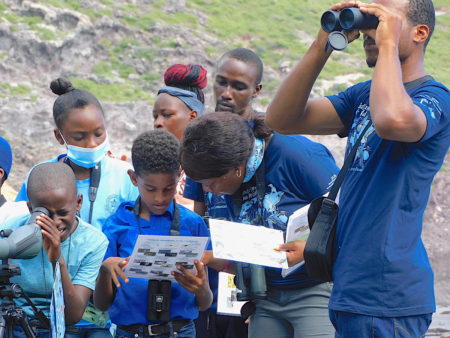
Enthusiasm is a key ingredient when observing, teaching, and talking about birds. For Ajhermae White, organizing a shorebird education initiative funded by BirdsCaribbean on her native Montserrat was a learning experience for her as well as her audiences, and a deeply satisfying one all around. Here is Ahjermae’s account of her journey as a shorebird educator – with young children, frigatebirds, and Government officials thrown into the mix.
The ‘Education on Shorebirds in Montserrat’ project is an initiative carried out by the island’s Department of Environment and sponsored by BirdsCaribbean. The aim is to spread awareness of shorebirds and their habitats. Once island residents learn more about these birds and understand their significance, the likelihood of threats to shorebirds, such as habitat destruction and human disturbance, will be reduced. As the project leader, I was really excited about the possible outcomes of this initiative.
The journey of being a shorebird educator has been a fulfilling experience. It has been a real privilege for me as the project leader to be given the opportunity to educate the local populace, in schools and among the general population about this fascinating topic. This has afforded me personal growth in addition to the enormous pleasure of sharing my passion for birds and their habitats.
Cleaning Up the Beaches Where Shorebirds Hang Out
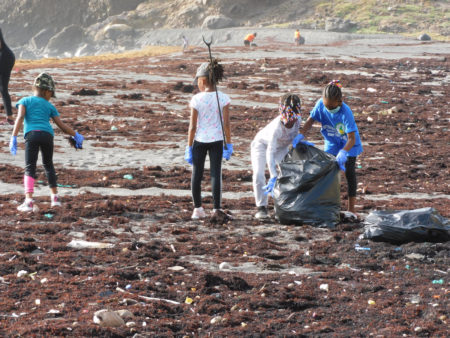
The first major activity of this project was hosting a beach clean-up, in August 2020. Together with my colleagues from the Department of Environment, we brought the local community together to clean a shorebird habitat ahead of the migratory season.
We chose Marguerita Bay, which is located on the eastern side of the island, for this clean-up. Debris is constantly deposited on this beach as a consequence with the tides of the Atlantic Ocean. Nonetheless, this beach has been a popular site for shorebirds on Montserrat during the migratory season.
It was a good turnout of volunteers of all ages, from various community groups. I found it quite surprising to see the various types of items that were collected from the beach. These included items such as fishnets, clothing items, shoes, and even a 20 pound propane bottle! This clean-up was a success. An amazing 1,300 pounds of trash was removed from the beach. As such, the beach was much cleaner for the 2020 fall migrants.
Click on photos to enlarge
Working in Schools and Communities
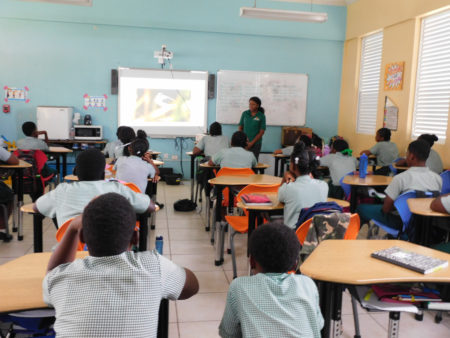
During the month of October 2020, we were out in the schools and communities, conducting outreach sessions. We gave presentations and organized field trips. We conducted outreach sessions with The Rotaract Club; grade classes in three primary schools; two groups with members of the public; and last but not least, an After School Club of four to six-year-olds.
For most of the school engagements, we made presentations in the afternoons. The following morning, we took the students out on the field trip, as soon as the school day started.
The students listened intently and participated actively in all the presentations, which was impressive. We talked to them about “What is a shorebird?” and went on to discuss their habitats, feeding habits, and threats to their survival. We then described some common shorebirds on Montserrat.
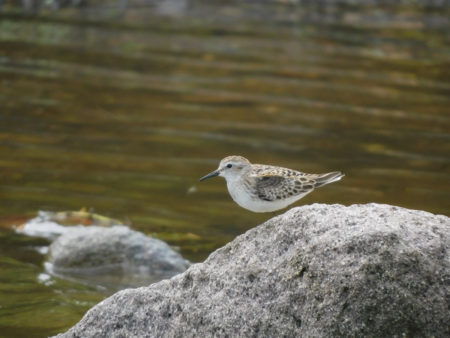
We made sure that these presentations included many pictures and videos of shorebirds and their habitats. Some classes had interesting questions. I specifically recall that during one presentation a student asked whether the Killdeer was the adult version of the Semipalmated Plover. When the student asked this, I felt a sense of gratification. This not only demonstrated that they were paying attention but that they were engrossed sufficiently to spot the similarities and differences and between the different species.
After every presentation, we gave the students a short quiz with spot prizes. After the quiz, every student was given a token (badge, sticker, pamphlet, or bird band). Needless to say, they were very excited to be “little ambassadors” for migratory shorebirds with their stickers and other tokens.
Meanwhile, Out in the Field…Frigatebirds Were a “Hit”
Our first stop for every field trip was the recently-cleaned Marguerita Bay, where students were thrilled to see shorebirds like the Sanderling, Pectoral Sandpiper, and the Semipalmated Sandpiper. However, as the month of October progressed, there were fewer sightings, as the shorebirds were moving on.
During every field trip at Marguerita Bay, we could count on the Magnificent Frigatebirds to put on a show by flying very low and putting on acrobatic performances when swooping down to drink water from the pond. It was as if they enjoyed the attention from the young bird-watchers, who could observe the sexual dimorphism in this species.
Even if there weren’t many shorebirds to see at the beach at the time of the visit, the Frigatebirds captivated the students. The After School Club birders (4-6 year olds) were mesmerized by the Magnificent Frigatebirds. I recall that I wasn’t certain whether these little ones would understand terms like “female”, “male” and “juvenile,” so to simplify for these kindergartners, I told them which frigatebirds were “girls”, “boys” and “babies”. They kept shouting out “That one’s a baby bird!” They were so funny.
Some of the information about the shorebirds was in Spanish, so I made sure that any student who spoke Spanish as a first language was able to see the Spanish names as well for the various species. Those students also received a Spanish Shorebird poster.
All Went Well With the Student Birders!
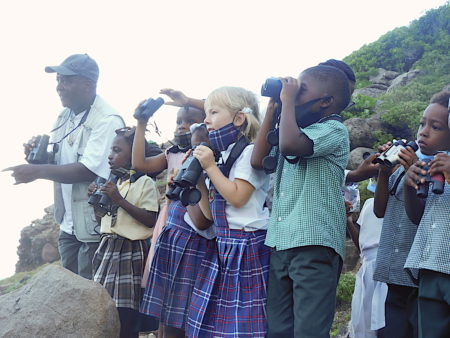
The second stop during the field trips was to Carr’s Bay. This area is near a busy road so we always took extra precautions when visiting this area. Students spotted species like the Sanderling, Lesser Yellowlegs, Greater Yellowlegs, Solitary Sandpiper, and others wading in the water. There were also a few other wetland bird species that the students were able to identify, such as the Common Gallinule and the Snowy Egret.
When we returned to the classroom we distributed refreshments and provided additional tokens. I gave students a shorebird word search that I created online, to help them remember the names of the shorebirds of Montserrat.
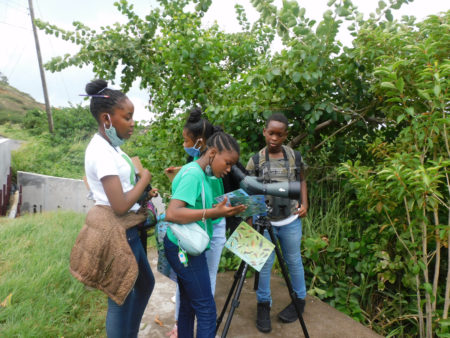
Although I always felt a little anxious before leading a field trip, I felt relieved afterwards, because they were successful and went ahead without mishaps. This was quite a responsibility for me, especially with the smallest bird enthusiasts. The students were able to see shorebirds and many other birds. Fortunately, there were no accidents during the field trips and even if it was a rainy day, the rain stopped long enough for the field trips to take place.
Engaging with the students was really gratifying. After the first few educational events, I started feeling more confident about putting myself out there to educate more students and the public. The enthusiasm that the students displayed showed me how much potential there is to impart knowledge to the younger generation, so that they can become more intensely aware of the avian biodiversity on Montserrat.
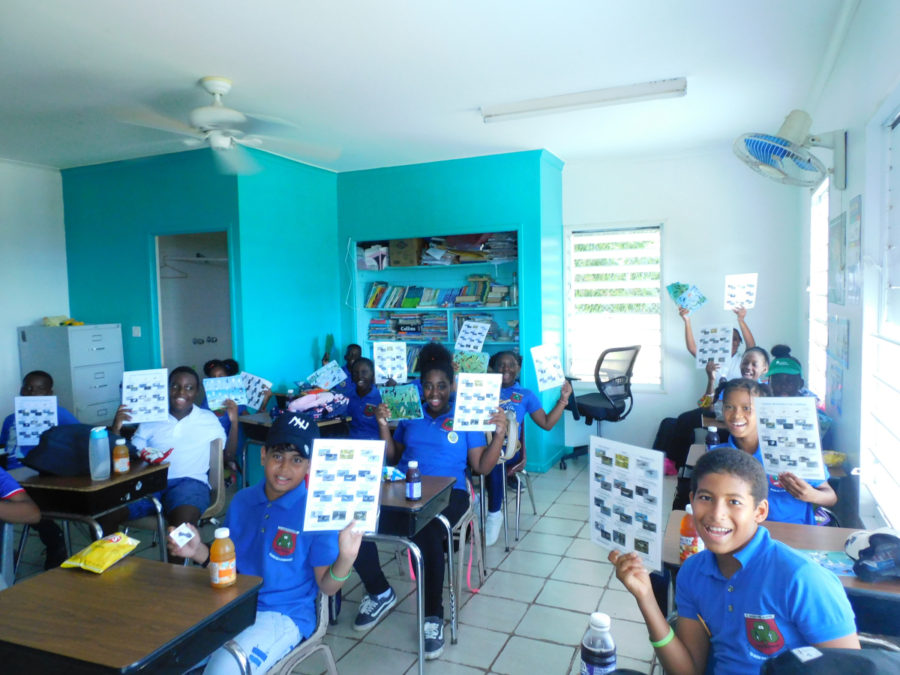
Radio, a Powerful Medium for Reaching People
We used radio a great deal during this project. We recorded a few radio spots to inform the public about shorebirds, their habitats and migration, playing shorebird calls to grab the listeners’ attention. The spots also informed listeners about some of the threats that these birds face, such as habitat loss and pollution. A few of our outreach activities were scheduled around World Migratory Bird Day (WMBD) so this celebration got coverage on the local news and the public was informed about the activities planned.
The Department of Environment was featured on the Ministry of Agriculture’s radio program called “MALHE VIBES” in October. On this live program, James ‘Scriber’ Daley (Forest Ranger) and I spoke about shorebirds and their habitats, informed listeners about our activities throughout the month, and used the opportunity to invite people to a public shorebird educational event. (See the end of this post for links to all Ajhermae’s radio appearances during this project!).
Great Support for Public Events – and a Government Minister, Too
We hosted public events to educate people in the community about shorebirds and give them opportunities to see shorebirds in their habitat. We advertised these events on the radio and on Facebook. I was really grateful to my co-worker, Thiffanie Williams, who created digital flyers to advertise the public events of this project.
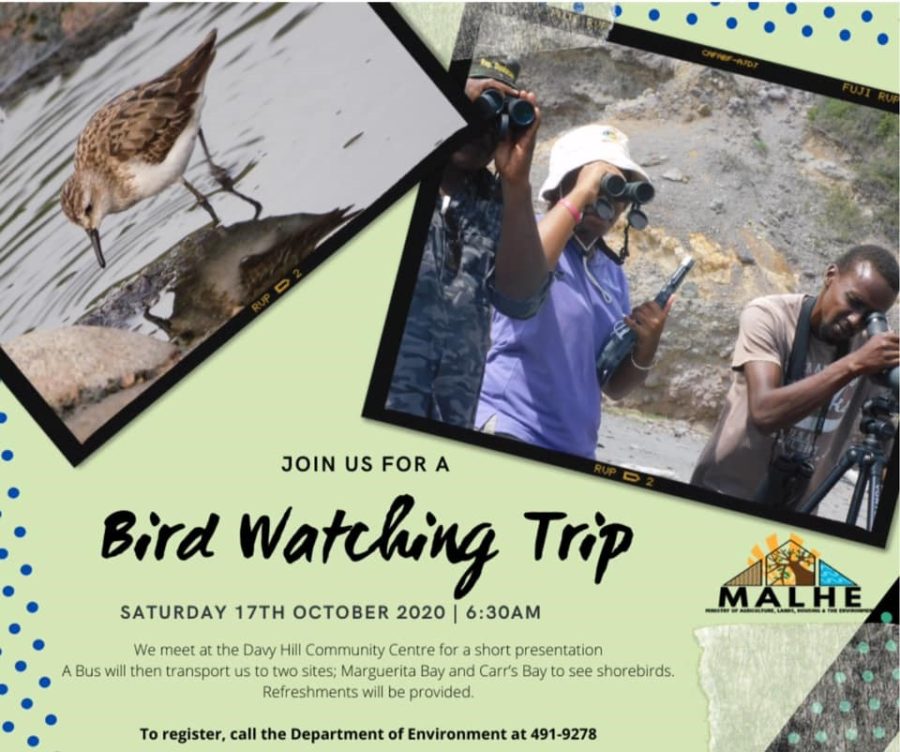
For the public events Scriber and I conducted presentations, starting at 6:30 am. This presentation covered the same topics as the school presentations – but this time, people of all ages attended these sessions. We also gave a mini-quiz to participants, with the opportunity to win a BirdsCaribbean tote bag. After stocking up on refreshments and equipping them with binoculars, the participants boarded a bus at 7:00 am. Just like the school field trips, we took the participants to Marguerita Bay and then to Carr’s Bay. At Marguerita Bay we didn’t see as many shorebirds as we had hoped to see but some seabirds were present.
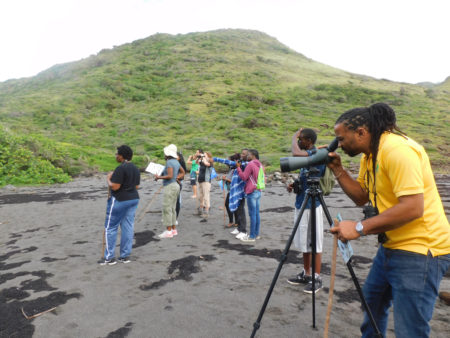
The radio sessions had clearly paid off, as residents of all ages attended the public birding events. I was particularly grateful that the Minister of Agriculture, Lands Housing and the Environment (MALHE), Hon. Crenston Buffonge and the Parliamentary Secretary, the Hon. Veronica Dorsette-Hector, each attended one of our public outreach sessions. It made me really pleased that these members of Parliament took part in these educational events and publicly showed their support for the project. This gave me hope for the future of wetlands on Montserrat.
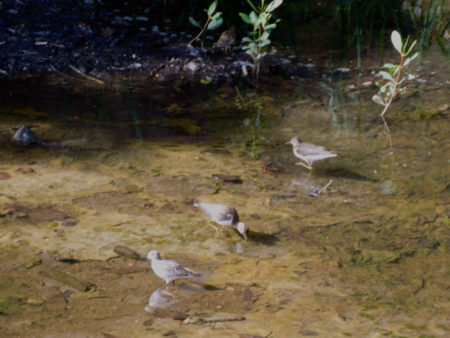
Carr’s Bay never disappointed us! On the first public birding trip, we saw fifteen different bird species at this site, including various species of shorebirds, like the Spotted Sandpiper and the Least Sandpiper! The first public birding trip was quite fulfilling for me because I saw two bird species that I had never seen before: the Merlin, and one that had eluded me many times – the Belted Kingfisher. The Minister jokingly commented that perhaps he and the other participants brought the good luck that allowed me to see these species.
It was quite satisfying to see when someone got an ‘aha moment’ after learning something new or finding out the name of a bird that they’ve often seen. A young girl, Kearah Ryan, who joined the second public birding trip, wrote a lovely blog about her experience. During that trip, Scriber and I were interviewed live on the radio by phone, informing the listeners about shorebirds, their habitats, migration, and the importance of protecting these birds. To my further delight, this clip was featured on ZJB Radio on the local news the following Monday. This served to boost my confidence as a shorebird educator.
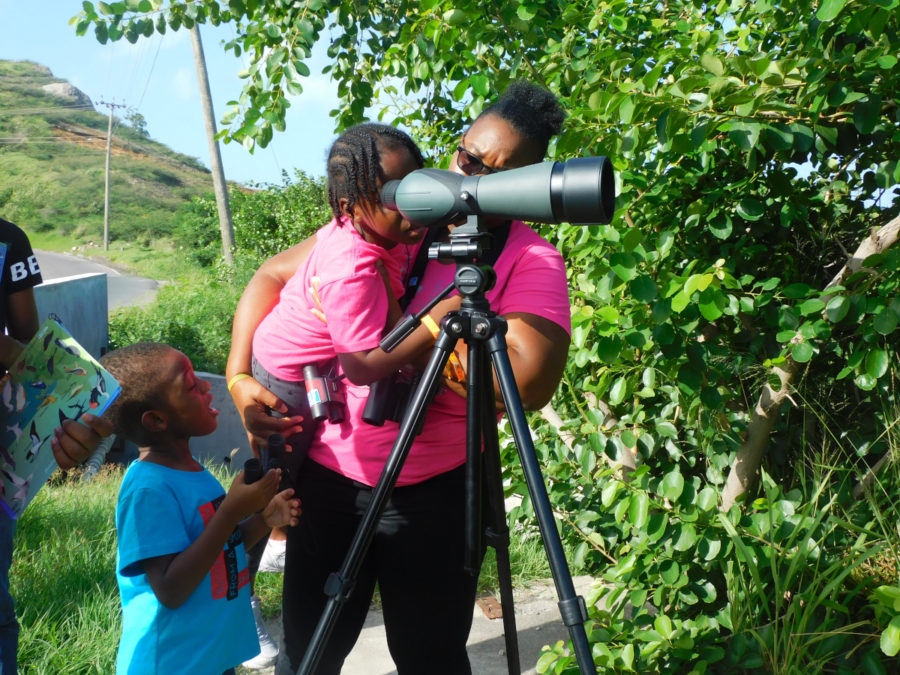
An Impactful Project, a Great Personal Experience
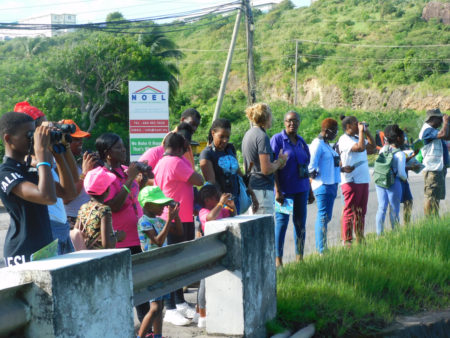
Overall, this project has been a resounding success! The Covid-19 pandemic had minimal impact on this educational project, as we have been fortunate in that Montserrat recorded no active cases between July 2020 and February 2021. With the use of the radio spots, the radio program, and the news, we effectively reached and educated many people locally about shorebirds and raised awareness about the threats that this group of birds face. So far we have directly engaged 145 persons, including two elected politicians. The feedback has been positive!
It is fair to say that I experienced personal growth while undertaking this project. It allowed me to sharpen my organizational skills, as quite a lot of planning and coordination was required to organize the clean-up and field trips. Additionally, with the wide coverage through the media and in-person presentations, my communication skills were also enhanced. As a direct consequence of this and the feedback I received, I am more confident to take on other projects in the future. I am therefore thankful to BirdsCaribbean for firstly, igniting my interest in birds, which allowed me to gain knowledge about avian species. Secondly, through their generous funding of this project I had the opportunity to educate Montserrat about this fascinating group of birds.
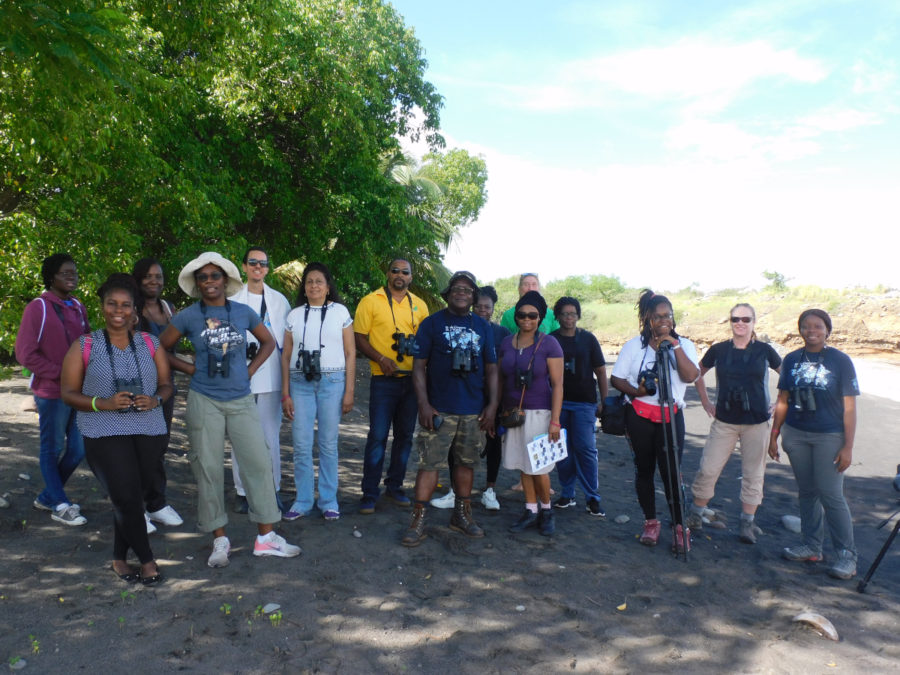
Ajhermae White is an Environment Officer from the Department of Environment in Montserrat. She received a small grant from BirdsCaribbean to support her in this project to help educate people on Montserrat about shorebirds, their habitats and conservation. Thank you to the US Fish and Wildlife Service, US Forest Service, Canadian Wildlife Service, and Manomet for supporting our Caribbean Waterbird Census and Shorebird Monitoring and Conservation Projects!
Check out the awesome live interviews of Ajhermae White and James “Scriber” Daley (Montserrat Dept of Environment) for their shorebird education events:
On Thursday 22nd October 2020, the Department of Environment were the guests on the Ministry of Agriculture’s radio program “MALHE Vibes” where they spoke about out shorebirds and the activities that they had been conducting for the Shorebird Education project (start at 2:34):
https://montserratradioecho.wordpress.com/2020/10/22/thursday-october-22-2020-mahle-vibes/
While on the Public bird watching trip at Carr’s Bay, Ajhermae got a chance to go live on ZJB Radio to let everyone know about our birding trip. Here is a link to that snippet of the radio program:
The birding trip was also featured on the morning news today! Here’s a link (Shorebird news starts at 8:03):
Check out this excellent video of the beach clean-up!
https://www.facebook.com/watch/live/?v=2413869538918800&ref=watch_permalink
One of the mini-birders on the public birding trip, Kearah Ryan, wrote a lovely blog post and shared photos about her shorebirding experience on Saturday. Here is a link to her blog:
http://kearahryan.com/shorebird-watching/
BirdsCaribbean note: We are so proud of Ajhermae White, a young conservation leader in Montserrat! Ajhermae attended our Conservation Caribbean Shorebirds International Training Workshop in Cabo Rojo, Puerto Rico in February 2019. Thank you to the Dept of Environment and James Scriber Daley for their incredible support! Many thanks also to the US Fish and Wildlife Service, Neotropical Migratory Bird Conservation Act Fund, Vortex Optics, Optics for the Tropics, and to our generous members and donors for supporting this project.


